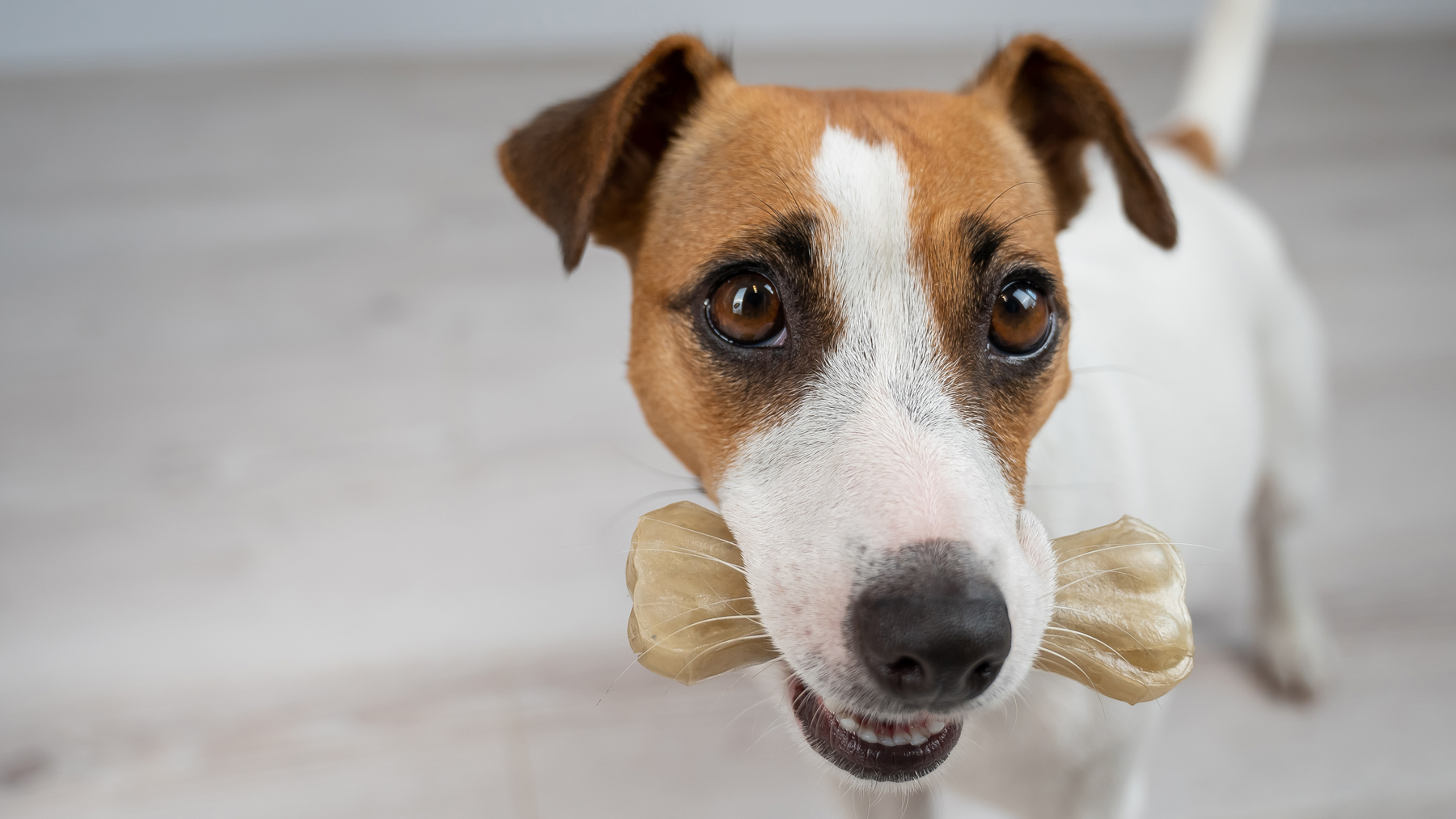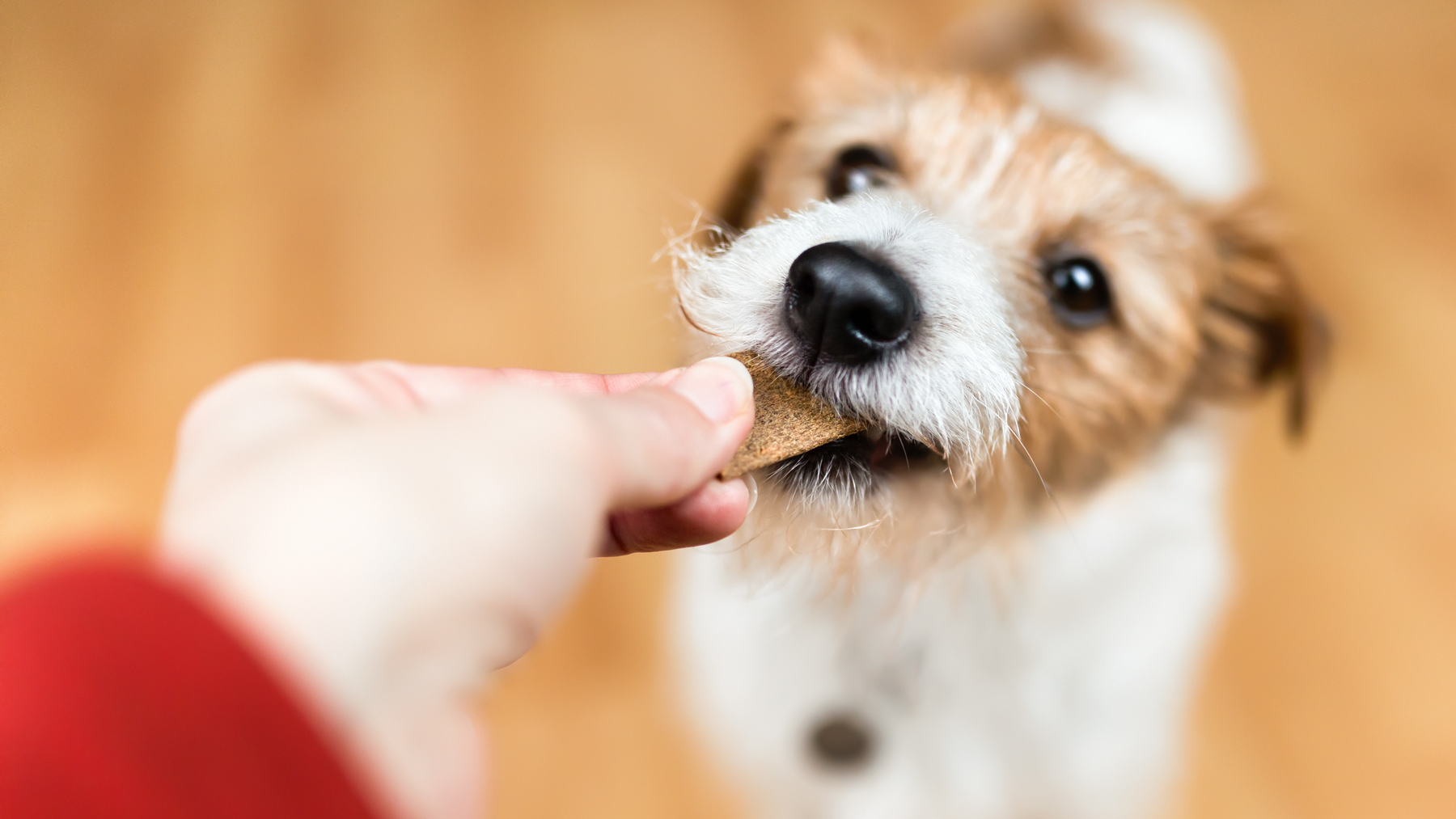
My lurcher, Dixie, recently started displaying some odd behaviors that I hadn’t seen before. While the longest lasting dog chews can be a great way to entertain your dog, for Dixie they ended up triggering a resource guarding instinct, driving her to hide them around the house.
It all started with a packet of dehydrated lamb tendons that I impulse bought from the butcher’s shop in my village. Dixie will love these, what a treat! I thought to myself as I brought them home and immediately handed her one to try. My lovely, gentle dog took it off me very carefully and then seemed to be casting around for somewhere to eat it, so I left her to it.
When I found her later the sofa was in disarray, her bed was upside down and she had a big red cut on her nose. As I watched, she attempted to throw a blanket over her treat while whining. She hadn’t eaten any of it but was instead trying her best to hide it. After watching her for a bit and realizing she wasn’t going to stop, I traded her for a piece of cheese (her favorite thing in the whole world) and sat with her until she calmed down and went to sleep.
I tried again a few weeks later, once her nose had healed, with a different sort of long-lasting chew (this time smaller and in my mind, easier to eat). Unfortunately, she did exactly the same thing, leaving me at a loss for what to do. I wanted my dog to be able to enjoy all the good things in life (like chews) but they seemed to be causing her a lot of stress.
We spoke to Orlagh McCarthy, a Dog Behaviorist and Trainer at Burns Pet Nutrition, who outlined exactly what the behaviors my dog was displaying were and some of the things you can do if your dog does the same.

McCarth is a qualified /Certified training and behaviour consultant, committed to ongoing CPD, regularly attending seminars with the world's most respected R+ trainers. She is also a housekeeper to 4 geriatric dogs: 3 Labradoodles, 1 Bichon and a DFD foster Golden Retriever puppy.
Learning about resource guarding and caching
Resource guarding
“Resource guarding is a natural behavior for dogs and some breeds such as Golden Retrievers or Cocker Spaniels have been selectively bred with enhanced resource guarding instincts. For instance, a working spaniel who retrieves a bird and allows someone else to take it from them would be a pretty useless gundog. By breeding these dogs together humans strengthened the behavior in many breeds,” explains McCarthy.
While resource guarding might not be typical lurcher behavior, Dixie was certainly displaying anxiety around her long-lasting treats. However, rather than being defensive of them, she was trying to hide them, and causing herself harm in the process. So was it simple resource guarding or something more?
Get the best advice, tips and top tech for your beloved Pets
Caching
“Caching is simply saving food for later. It’s an innate behavior that some dogs exhibit more than others. It often happens if they are too full to finish a meal, or take something lovely but want to protect it for themselves,” says McCarthy. “You will see dogs ‘hide’ things under blankets etc where they scoop the blanket with their nose as if filling in a hole. It’s similar to dogs burying bones or their favorite toys – to keep them safe and hidden until later.”
So Dixie’s behavior was natural, but I worried about the damage she seemed to be doing to her nose. She still has a little bald, discoloured patch just above her nose from doing this behavior repeatedly, even once the treat was well hidden.
“In some cases, dogs do not feel comfortable enough to eat in front of people or other animals as they are more vulnerable when eating. These dogs may cache their food and eat it at a later date when they are alone, for instance in the middle of the night” says McCarthy.
“Burying treats is partially instinctual generally speaking, but also can be linked to resource guarding or anxiety in dogs. More common than not though, it’s because they want to save the treat for later,” she adds.
Working with a complex case of resource guarding
So, we had concluded that my dog likes to cache her special treats, particularly those that will take her a while to eat. While the caching behavior wasn’t inherently bad, Dixie’s obsessiveness and the anxiety she was displaying when given a long lasting chew made me reluctant to give her anything high-value that would take her more than a few seconds to eat.
While it wasn’t a straight-up case of resource guarding, it was clear to me that Dixie was stressed about the nice thing that she had been given would be taken off her again.
“Dogs that are anxious or prone to resource guarding might hide their favorite things more often. Generally speaking it’s a harmless behavior, but some dogs do become anxious about their precious items and worry about them being uncovered,” says McCarthy.

Solving the problem
“Vigilance and careful resource management are key to helping your dog feel secure around things that THEY deem valuable,” advises McCarthy. My resource management ended up coming in the form of different treats: I discarded the long lasting chews and now favor smaller, bite-sized treats for Dixie. In the case of the lamb tendons, I rehydrated them to make them softer and then cut them up into smaller pieces so that Dixie could just swallow them straight down.
“The best option is to teach dogs that human hands do not take valuable things away – dogs should be allowed to eat in peace. Owners should hand feed puppies to show that hands provide goodies not take them away,” says McCarthy. “Teaching a cue like ‘Thank you’ which always pays a delicious treat will encourage a dog to drop what is in their mouth when they hear the cue.”
As Dixie is a rescue dog, I don’t know what sort of experiences she had before she came to me. Unfortunately, lots of human behaviors can trigger this instinct in dogs, so it’s possible that she has a bad memory associated with these long lasting chews that makes her keen to hide them. “Taking a dog’s dish or bone to show you can and to prove who is boss will encourage resource guarding and develop mistrust between a dog and their owner,” explains McCarthy. “Resource Guarding is a natural behavior and so must not be punished but it is our responsibility to address it and teach the dog an incompatible and alternative behavior.”
Lou is an experienced writer and keen dog lover who works at PetRadar's sister site, LiveScience. When Lou isn't covering health and fitness, she's busy spending time with her family dogs or growing all kinds of veggies and flowers on her allotment.
